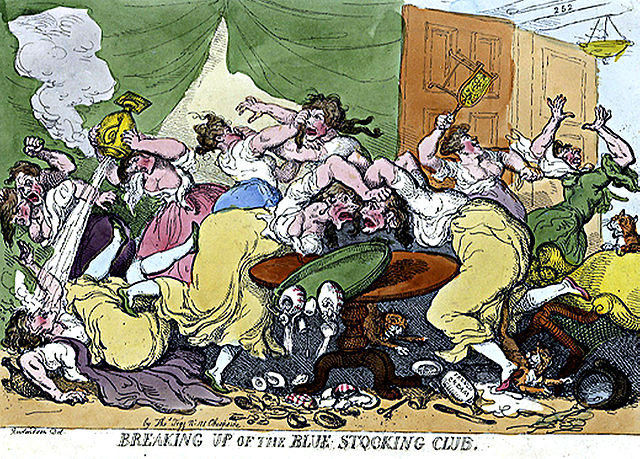Bluestocking is a term for an educated, intellectual woman, originally a member of the 18th-century Blue Stockings Society from England led by the hostess and critic Elizabeth Montagu (1718–1800), the "Queen of the Blues", including Elizabeth Vesey (1715–1791), Hester Chapone (1727–1801) and the classicist Elizabeth Carter (1717–1806). In the following generation came Hester Lynch Piozzi (1741–1821), Hannah More (1745–1833) and Frances Burney (1752–1840). The term now more broadly applies to women who show interest in literary or intellectual matters.
Portrait of Bluestockings by Richard Samuel
Caricature of blue stockings by Rowlandson
The Blue Stockings Society was an informal women's social and educational movement in England in the mid-18th century that emphasised education and mutual cooperation. It was founded in the early 1750s by Elizabeth Montagu, Elizabeth Vesey and others as a literary discussion group, a step away from traditional, non-intellectual women's activities. Both men and women were invited to attend, including the botanist, translator and publisher Benjamin Stillingfleet, who, due to his financial standing, did not dress for the occasion as formally as was customary and deemed "proper," in consequence appearing in everyday blue worsted stockings.

Portraits in the Characters of the Muses in the Temple of Apollo, 1778, 130 cm × 150 cm (52 in × 61 in), by Richard Samuel. The sitters are: Anna Letitia Barbauld (1743–1825), poet and writer; Elizabeth Carter (1717–1806), scholar and writer; Elizabeth Griffith (1727–1793), playwright and novelist; Angelica Kauffmann (1741–1807), painter; Charlotte Lennox (1720–1804), writer; Catharine Macaulay (1731–1791), historian and political polemicist; Elizabeth Montagu (1718–1800);
The centre house, 16 Royal Crescent, Bath, was used as a residence and to host Blue Stockings Society events by Elizabeth Montagu
Satiric drawing by Thomas Rowlandson (1756–1827), "Breaking Up of the Blue Stocking Club" (1815)




